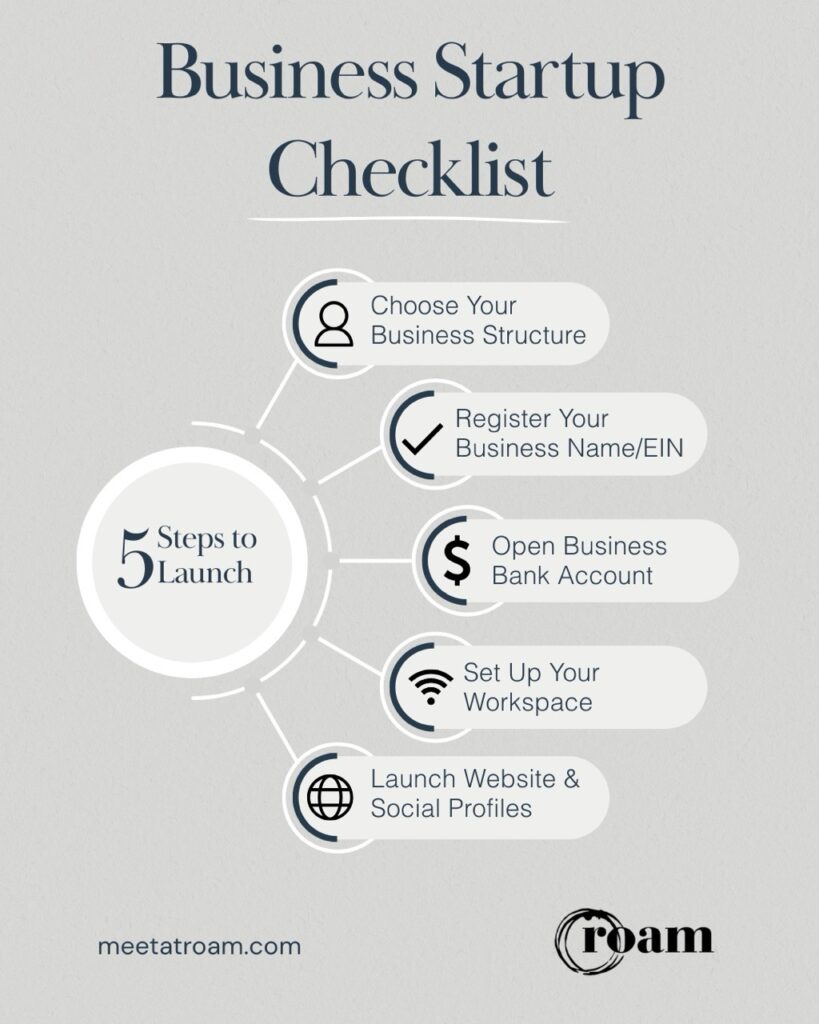Business Startup Checklist: Your Blueprint for Launch Success
The Short Answer: Starting a small business requires a clear business plan, legal registration, financial setup, business location, and operational systems in place. These five foundational elements help new business owners launch confidently while staying in line with regulatory requirements. (And yes, it’s less scary than it sounds!)
Starting a new business can feel like trying to assemble furniture without instructions: lots of moving parts, confusing diagrams, and the sneaking suspicion you’re missing a crucial screw. Many first-time business owners find themselves scratching their heads over legal requirements, hunting for adequate funding, searching for the perfect workspace, and building effective business operations. Without proper guidance, these challenges can back up your startup journey or lead to some seriously expensive “learning experiences.”
To launch your business properly, you’ll need to focus on five main areas:
- Developing a solid business plan
- Completing legal registrations and permits
- Setting up business finances and accounts
- Establishing a professional business location
- Creating basic operational procedures
This business startup checklist breaks down exactly what you need in each category, so you can move forward with confidence instead of confusion.
The good news? By following a structured approach and tackling each requirement step by step, you can navigate the startup process successfully without unnecessary stress or burden. Let’s explore what you need to get your business off the ground!

Step 1: Choose Your Business Structure
The first major decision in your startup journey is choosing your legal structure; think of it as picking your business’s personality type. Here are your main options:
- Sole proprietorship: Works well for individuals running a business alone, with minimal startup costs and simple tax filing through your personal return. Consider this the “keep it simple” option.
- Limited Liability Companies (LLCs): Provide personal asset protection and tax flexibility, making them popular among small business owners.
- Corporations: Offer the strongest liability protection but involve more complex regulatory requirements and double taxation.
- General partnership: Perfect if you’re teaming up with someone.
- Limited partnership: Great when you want different levels of involvement.
Step 2: Complete Required Documentation
Your business startup checklist begins with registering your business name through your state’s Secretary of State office. Next, apply for an Employer Identification Number (EIN) through the Internal Revenue Service website. This acts like a Social Security number for your business (your business entity’s very own ID card!). Check with your local government and the Department of Revenue for required business licenses and permits, which vary by industry and location.
Common insurance needs include:
- General liability insurance
- Professional liability insurance if you provide services
- Workers’ compensation if you’re planning on hiring employees
Pro tip: Find a good insurance agent who you trust and speaks in straightforward language, not insurance jargon. And if you’re working as an independent contractor or sole proprietor, make sure you’ve got your ducks in a row with unemployment insurance requirements too.
Local Compliance
Each state has different rules for business operations and registration; research your state’s specific requirements through its Department of Revenue website. Industry regulations might require special certifications or inspections. Restaurants need health permits, while contractors need trade licenses. Check your local zoning laws to confirm your chosen business location allows commercial activities. Home-based businesses often need special permits, and some neighborhoods have rules stricter than a homeowners’ association.
Don’t forget about the fun stuff like annual reports (they come around faster than you think!) and keeping your contact information up to date with the trademark office if you’re protecting intellectual property. Consider starting your business in a flexible workspace like Roam, which handles many compliance headaches like commercial zoning and building safety requirements, allowing you to focus on actually growing your small business instead of drowning in paperwork.

Step 3: Open Your Business Bank Account
Banking Setup
Setting up proper banking infrastructure marks the start of your new business’s financial journey! Most banks offer specialized business checking accounts with features like higher transaction limits and cash deposits. Look for a bank account with low monthly fees and minimum balance requirements that match your expected cash flow.
Business credit cards provide purchasing power and help track expenses separately from personal spending (goodbye, “Did I buy that for work or for me?” confusion). When choosing payment processing, consider options like Square, Stripe, or PayPal based on your business structure and typical transaction size.
Startup Budget Planning
A well-planned business plan helps business owners avoid cash flow problems in their first year, because running out of money isn’t fun for anyone. Consider these main expense categories when planning:
Initial Costs:
- Business license and permits
- Equipment and supplies
- Website and brand identity
- Initial inventory (if you’re selling physical products)
- Professional services (legal/accounting/marketing—yes, you need them!)
Monthly Operating Expenses:
- Business location rental or membership
- Utilities and internet
- Software subscriptions
- Marketing strategy budget
- Insurance premiums
Set aside 3-6 months of operating expenses as an emergency fund to handle unexpected costs or slow periods. Your financial projections should be optimistic but grounded in reality (unicorns are great, but let’s keep them out of your spreadsheets).
Financial Tools
Modern accounting software simplifies business operations management without requiring a math degree. QuickBooks Online or FreshBooks work well for small businesses, offering features like invoice creation, expense tracking, and financial projections. For expense management, apps like Expensify help track receipts and categorize spending.
If you’re hiring employees (welcome to the world of H.R.!), consider payroll services like Gusto or ADP, which handle tax withholding and direct deposits automatically.
Review your financial setup quarterly and adjust your tools and systems as your business grows. Professional workspace solutions, like Roam’s coworking memberships, offer flexible terms that work with startup budgets while providing a professional environment for client meetings and daily operations.
Step 4: Set Up Your Workspace
Your workspace choice shapes your business operations and impacts business success; it’s where the magic happens! When starting out, you have several practical options that balance cost with professional needs.
Workspace Options
A home office offers a sole proprietor a budget-friendly starting point. Set aside a dedicated room or space away from household distractions (yes, that means away from the snack cabinet and the TV). Consider factors like lighting, background noise, and reliable internet connectivity. While cost-effective, home offices can blur work-life boundaries faster than you can say “just one more email” at 10 PM.
Coworking spaces provide professional environments without the long-term commitment concerns of traditional leases. At Roam, you’ll find flexible workspaces designed for focus and productivity, not to mention built-in networking opportunities and a full-service coffee bar. These spaces offer professional meeting rooms and the ability to scale as your small business grows.Traditional office leases make sense for businesses needing dedicated storage space or specific layouts. However, they often require substantial upfront costs and long-term commitments.

Professional Setup Features
Modern workspaces should include:
- High-speed internet
- Ergonomic furniture (your back and neck will thank you)
- Proper lighting
- Meeting areas
- Storage solutions
- Break room access
Technology and Equipment
Focus on these basics to get started:
Technology
- Reliable computer or laptop
- Backup storage solution (because “the cloud ate my homework” doesn’t fly)
- Business software subscriptions
- Quality headphones with microphone
- Mobile phone
Office Supplies
- Basic desk supplies
- Filing system
- Business cards
- Printer/scanner combo
- Paper supplies
Communication Tools
- Video conferencing setup
- Virtual phone system
- Project management software
- Document sharing platform
- Professional email address
Remember to factor these workspace and equipment costs into your initial business startup checklist. Starting with the right setup helps avoid costly changes later and supports smooth business operations from day one.
Step 5: Launch Website & Social Profiles
Brand Development
Your small business needs a strong brand identity to stand out in a crowded market. You want potential customers to remember you, not confuse you with every other business out there. Start with a memorable logo and consistent brand colors that reflect your company values. Design professional business cards and letterheads using these elements.
Build a user-friendly website that clearly explains your products or services, and include an “About Us” page that tells your startup journey. Set up business profiles on major social platforms like LinkedIn, Instagram, and Facebook, making sure everything matches your marketing strategy and website’s look and message.
Customer Acquisition
Market research shows your potential customers’ age, location, income, and buying habits. Basically, you’re doing some friendly detective work. Use this data to pick the right marketing channels for your target market:
- If your customers are professionals aged 25-45, LinkedIn and email marketing might work well
- For younger audiences, Instagram and TikTok could be better choices
Build a marketing plan that includes both online and offline strategies. This might mean combining digital advertising with local networking events or trade shows.
Operations Management
Set up business operations systems to handle daily tasks smoothly, because winging it only works for so long. Choose a project management software like Trello or Asana to track work and deadlines. Pick communication tools that fit your team size. Slack works well for quick chats, while Zoom handles video meetings. Create clear processes for handling customer service, processing orders, and managing inventory if needed.
A professional workspace helps organize these operations effectively without the chaos. Consider a coworking space at Roam, where you’ll find meeting rooms for client presentations and quiet areas for focused work. This setup gives you flexibility as your business grows, without the ball-and-chain commitment of a traditional office lease.
Small changes in your operations can make big differences in productivity. Track which processes work well and which need updates. Use feedback from customers and team members to improve your systems regularly, because even the best checklist needs tweaking sometimes.

Ready for Launch: Your Startup Checklist for Business Success
Starting a new business requires completing several practical steps after your initial business plan phase. You’ll need to:
- Register your business name
- Obtain necessary business licenses
- Set up your business location
- Begin implementing your marketing strategy
Think of this business guide as your roadmap to becoming an official business owner!
Once you’ve completed your business plan and legal requirements, it’s time to bring your business entity to life. Start by filing your business registration with the Secretary of State and obtaining your employer identification number from the Internal Revenue Service. Next, secure any industry-specific permits and licenses needed for your location. Set up a bank account and accounting system to track cash flow from day one, because knowing where your money is going beats guessing any day.
Your workspace decisions will shape your daily business operations and productivity. While a home office works for some business owners, many entrepreneurs find that a professional coworking space provides the structure and resources needed for growth without the overhead nightmares. Roam offers flexible workspace solutions that grow with your business, featuring private offices, meeting rooms, and networking opportunities in a professional environment that actually feels professional. Read about their very own startup story here!
Looking for additional resources? Connect with your local Small Business Administration office, join entrepreneur meetup groups, or schedule a tour at Roam to explore workspace options that match your business needs.
Your startup journey starts with a strong foundation, and we’re here to help you build it without the stress and guesswork. Now go forth and conquer! You’ve got this.
